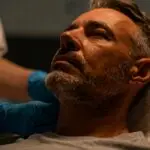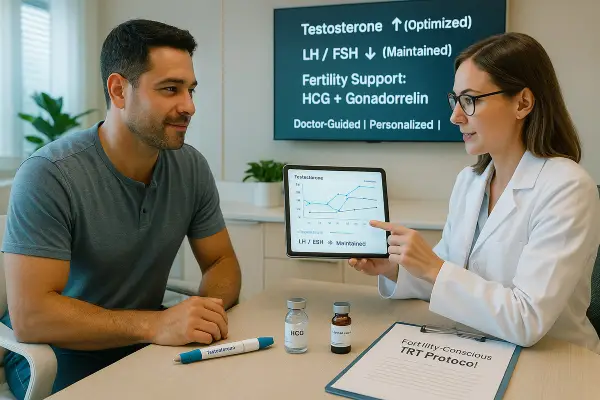Blog
TRT and Fertility: How to Maintain Fertility While on Testosterone Therapy

Many men starting testosterone replacement therapy (TRT) worry about its effect on fertility. It’s true that introducing external testosterone causes the brain to dial down its own signals (LH and FSH) to the testicles, often shrinking testicles and slowing sperm production. In fact, studies show that exogenous TRT can shut down the hypothalamic-pituitary-gonadal (HPG) axis so completely that semen can go to zero (azoospermia) in as little as 10 weeks. And alarmingly, about 10% of men remain azoospermic even months after stopping TRT. This FAQ explains why testosterone therapy suppresses sperm and how medically supervised protocols (including HCG and gonadorelin) can preserve fertility.
How Does TRT Lower Sperm Count and Fertility?
Q: Why does taking testosterone cause low sperm counts?
A: When you take testosterone (gel, injection, pellet, etc.), your pituitary gland senses the extra hormone and “thinks” your levels are high. It responds by cutting off the signals (LH and FSH) that normally stimulate your testicles. Without LH, intratesticular testosterone drops dramatically, and sperm production falters. In simple terms, TRT creates a feedback block: you get testosterone in your blood from outside, but your testes stop making the testosterone inside that’s needed for sperm. Men on standard TRT often see a steep fall in sperm count – sometimes falling well below the normal range within months. This is often accompanied by testicular shrinkage due to the lack of LH stimulation.
Key point: TRT by itself is a form of birth control. It raises blood T but suppresses the HPG axis, so sperm output plummets.
This phenomenon is well-documented. For example, a 2018 review noted that exogenous testosterone can “impair spermatogenesis with azoospermia being a serious possible result,” effectively rendering a man temporarily infertile. Another clinical source warns that “testosterone therapy can reduce your sperm count further,” so it’s generally not recommended for men actively trying to conceive. In many cases, the drop in sperm is reversible after stopping TRT, but recovery can be slow (often 6–12 months) and isn’t guaranteed. Up to 10% of men may remain without sperm even after discontinuation. That’s why proactive strategies are crucial if you plan to father children.
Preserving Fertility on TRT: HCG, Gonadorelin, and Clomid
Q: Can fertility be maintained while on TRT?
A: Yes. Doctors use additional therapies to protect spermatogenesis. The two main hormone-based approaches are HCG and gonadorelin (GnRH). A third option – Clomid (clomiphene citrate) – is sometimes used in select cases. All of these treatments aim to “trick” or stimulate the testes to keep working, even when you’re taking testosterone.
HCG (Human Chorionic Gonadotropin) with TRT
- What it is: HCG is a hormone similar to LH. It acts like a stand-in for the LH signal that the pituitary normally sends to the testes.
- How it helps: By injecting HCG while on TRT, you effectively tell your testes “keep making testosterone and sperm,” despite the suppressed pituitary. It maintains high intratesticular testosterone and supports spermatogenesis.
- Evidence: Clinical studies confirm HCG’s power. For example, men on TRT who also took low-dose HCG (250–500 IU every other day) preserved their testicular testosterone: intratesticular T levels fell only ~7% with HCG compared to a 94% drop on TRT alone. One review explains that adding HCG to TRT can “maintain elevated intratesticular testosterone levels” and even reverse TRT-induced azoospermia.
- Usage: HCG is typically given by injection (often subcutaneously 2–3 times per week) alongside your testosterone. The dose can be adjusted based on sperm count and testis size.
- Benefits: Preserves sperm count and testicular size during TRT; may speed fertility return after stopping TRT.
- Considerations: HCG can raise estrogen levels, so doctors monitor hormones closely. Some men also develop transient acne or gynecomastia if doses are high. But overall, HCG is a well-established fertility-preserving adjunct to TRT. A Mayo Clinic-backed review noted that HCG has a “prominent role…to prevent testicular atrophy and maintain response to TRT.”
Gonadorelin (GnRH analog) for Fertility
- What it is: Gonadorelin is a synthetic form of GnRH (gonadotropin-releasing hormone), the brain’s own signaling molecule that triggers LH and FSH release from the pituitary.
- How it helps: Instead of directly replacing LH like HCG does, gonadorelin stimulates your pituitary to dump LH (and FSH) back into circulation naturally. This can “rev up” your testes endogenously. It is typically given as a short injection in pulses (mimicking natural GnRH rhythm).
- Evidence: Gonadorelin is a newer approach in TRT programs. While there are fewer large trials, preliminary data and clinical experience suggest it can effectively sustain some level of natural LH/FSH production and thus support testicular function. One urologist notes that gonadorelin “may effectively stimulate endogenous testosterone and sperm production” with minimal side effects.
- Usage: It’s usually prescribed as an injection multiple times per week or daily, often in a pulsatile fashion. The exact protocol is personalized.
- Benefits: Because it reactivates your own HPG axis, gonadorelin carries a low risk of desensitizing receptors. It can preserve fertility similarly to HCG but may have a gentler effect on estrogen levels.
- Considerations: Availability and insurance coverage can be issues, as gonadorelin is less common. Some clinicians prefer HCG due to its long track record, while others like gonadorelin’s physiologic approach. In practice, both options can work, and the choice depends on individual needs.
Clomiphene (Clomid) and SERMs
- What it is: Clomiphene citrate is a selective estrogen receptor modulator (SERM). It is an oral medication commonly used off-label in men to boost their own testosterone production.
- How it helps: Clomid blocks estrogen feedback at the hypothalamus and pituitary. This drives an increase in LH and FSH release, which can raise testicular testosterone and sperm production. In other words, it stimulates your own axis instead of providing exogenous hormone.
- Evidence: Studies show Clomid consistently raises total testosterone and often improves sperm counts in men with hypogonadism. For example, a review notes that SERMs “elevate total testosterone levels and maintain spermatogenesis” in men on testosterone therapy. However, the sperm response to Clomid alone can be variable.
- Usage: Clomid is taken as a daily oral pill. It is sometimes used alone in lieu of TRT (especially in younger men trying to conceive) or added temporarily to a TRT regimen if fertility is urgently needed.
- Benefits: It avoids giving extra testosterone, so it has minimal risk of further suppressing the HPG axis. Many men on Clomid report improved libido and energy.
- Considerations: Clomid (Clomiphene) can have side effects (mood swings, vision changes, etc.), and its impact on sperm isn’t guaranteed. Some men paradoxically experience a decrease in semen parameters on Clomid. It’s also slower acting: sperm improvements may take 3–9 months. Still, Clomid is a tool in the fertility arsenal, and our doctors can discuss if it suits you (for some men with borderline low T, Clomid can be an option to stimulate natural production).
Bullet summary of fertility strategies:
- HCG with TRT: Mimics LH to maintain intratesticular T and sperm production. Proven to preserve testicular function in TRT users.
- Gonadorelin (GnRH analog): Stimulates pituitary to release LH/FSH naturally. Emerging option that can sustain the axis on therapy.
- Clomiphene (SERM): Raises LH/FSH via estrogen blockade. Often used post-TRT or in lieu of TRT to boost both T and sperm.
Each man’s situation is different. In general, adding some form of gonadotropin support (HCG or GnRH) is highly advisable if fertility is a priority. These therapies make it possible to enjoy the benefits of TRT (improved energy, libido, mood, etc.) without completely sacrificing your sperm count.
LIVV’s Doctor-Guided TRT Program: Personalized Hormone Therapy and Fertility
Q: How does LIVV address fertility in TRT plans?
A: At LIVV Natural, we understand that men want the relief of optimized testosterone and the option of future parenthood. That’s why our TRT Program is doctor-guided, personalized, and fertility-aware. We use licensed naturopathic physicians to design your treatment protocol based on your labs, goals, and life stage.
- Thorough Evaluation: We start with comprehensive lab testing. Along with total and free testosterone, we measure LH, FSH, estradiol, and other markers. This hormone panel tells us where your HPG axis stands before treatment, so we can plan accordingly.
- Expert Consultation: Every patient meets one-on-one with a LIVV doctor who specializes in men’s hormones. We review your history and labs together (in plain language) and explain options. Our doctors are trained to look at the whole picture, not just numbers. They’ll discuss fertility goals up front.
- Customized Treatment: Based on this workup, your doctor prescribes the exact form and dose of testosterone you need (injection, gel, etc.), and tailors any add-ons. For example, a man eager to have children might start on the low end of TRT dosing plus HCG from the beginning. Another patient might use CJC-1295/Ipamorelin peptides for body-composition goals (see our blog on CJC-1295 + Ipamorelin for more). Every decision is justified by lab data and your feedback.
- Fertility-Preserving Peptides: Crucially, our protocols can include HCG or gonadorelin to keep your testes active on therapy. Many clinics skip this step, but we make it an option if you need it. This way, “fertility preservation” isn’t an afterthought – it’s built into the plan.
- Ongoing Monitoring: We re-test your hormones (and sometimes semen analysis) regularly. If any adjustments are needed – say, we increase HCG or add an AI to balance estradiol – it’s done quickly. You’ll have follow-up bloodwork every few months. The goal is to hit your testosterone target and keep LH/FSH and sperm in a healthy range.
- Supporting Services: As part of our precision protocol, you have access to the Doctor Consultation – Precision Protocol product. This ensures you can ask questions, tweak therapy, and plan for fertility at any time.
Bottom line: LIVV’s approach is holistic and individualized. We never use a one-size-fits-all dose of testosterone. Instead, we balance your hormone needs with your fertility goals. Whether that means adding HCG, Gonadorelin, or considering Clomid, the strategy is always guided by evidence and experience. As one clinical review highlights, “for men of reproductive age…preservation of fertility is an important aspect of [hypogonadism] treatment” – and that’s exactly what we do at LIVV.
Key Takeaways and Next Steps
- Understand TRT fertility risk: Exogenous testosterone will shut off your LH/FSH and sperm production. If you plan to have children soon, don’t start TRT without a plan.
- Ask about HCG/GnRH: If you’re starting TRT and concerned about fertility, talk to your doctor about adding HCG or a GnRH therapy. These hormones keep your testes active.
- Consider Clomid: In younger men wanting fertility, Clomiphene (Clomid) alone is sometimes used to raise testosterone without shutting down sperm. It’s an alternative to full TRT.
- Monitor and customize: Make sure you have regular lab checks (including LH, FSH, estradiol, and possibly semen analysis) and ongoing medical supervision. Each man’s fertility needs a slightly different approach.
- LIVV’s programs: Learn more about our [TRT Program] and fertility protocols. Our licensed doctors will tailor a safe plan so you can enjoy the benefits of TRT and keep your fertility on track.
Fertility on TRT is a solvable problem
With modern protocols, you don’t have to sacrifice future children for hormone optimization. By using fertility-sparing therapies like HCG or gonadorelin under medical guidance, most men can preserve healthy sperm levels while feeling the full effects of TRT. Always work with a knowledgeable provider—like the team at LIVV—who will prioritize both your hormone health and your reproductive goals.

